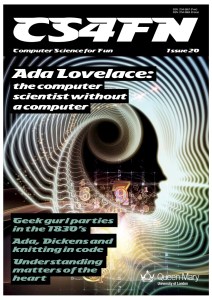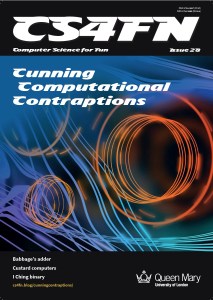Preventing robots from hurting us
by Paul Curzon, Queen Mary University of London
The first rule of humans when around robots is apparently that they should not do anything too unexpected…
A 7-year old child playing chess in a chess tournament has had his finger broken by a chess-playing robot which grabbed it as the boy made his move. The child was blamed by one of the organisers, who claimed that it happened because the boy “broke the safety rules”! The organisers also apparently claimed that the robot itself was perfectly safe!
What seems to have happened is, after the robot played its move, the boy played his own move very quickly before the robot had finished. Somehow this triggered the wrong lines of code in the robot’s program: instructions that were intended for some other situation. In the actual situation of the boy’s hand being over the board at the wrong time it led the robot to grab his finger and not let go.
Spoiler Alert
The situation immediately brings to mind the classic science fiction story “Moxon’s Master” by Ambrose Bierce published way back in 1899. It is the story of a chess playing automaton (ie robot) and what happens when it is check-mated when playing a game with its creator Moxon. It flies into a dangerous rage. However, there the problems are apparently because the robot has developed emotions and so emotional reactions. In both situations however a robot intended simply to play chess is capable of harming a human as a result.
The three laws of robotics
Isaac Asimov is famous for his laws of robotics: fundamental unbreakable rules built in to the ‘brain’ of all robots in his fictional world precisely to stop this sort of situation. The rules he formulated were:
- A robot may not injure a human being or, through inaction, allow a human being to come to harm.
- A robot must obey the orders given to it by human beings except where such orders would conflict with the First Law.
- A robot must protect its own existence as long as such protection does not conflict with the First or Second Law.

Clearly, had they been in place, the chess robot would not have harmed the boy, and Moxon’s automaton would not have been able to do anything too bad as a result of its temper either.
Asimov devised his rules as a result of a discussion with the Science Fiction magazine editor John W. Campbell, Jr. He then spent much of his Science Fiction career writing robot stories around how humans could end up being hurt despite the apparently clear rules. That aside their key idea was that, to ensure robots were safe around people, they would need built-in logic that could not be circumvented to stop them hurting them. They needed a fail-safe system monitoring their actions that would take over when breaches were possible. Clearly this chess-playing robot was not “perfectly safe” and not even fail-safe as if it was the boy would not have been harmed whatever he did. The robot did not have anything at all akin to a working, unbreakable First Law programmed into it.
Dangerous Machines
Asimov’s robots were intelligent and able to think for themselves in a more general sense than any that currently exist. The First Law essentially prevented them from deciding to harm a human not just do so by accident. However, perhaps the day will soon come when they can start to think for themselves, so perhaps a first law will soon be important. In any case, machines can harm humans without being able to think. That humans need to be wary around robots is obvious from the fact that there have been numerous injuries and even fatalities in factories using industrial robots in the decades since they were introduced. They are dangerous machines. Fortunately, the carnage inflicted on children is at least not quite that of the industrial accidents in the Industrial Revolution. It is still a problem though. People do have to take care and follow safety rules around them!
Rather than humans having to obey safety laws, we perhaps ought to be taking Asimov’s Laws more seriously for all robots, therefore. Why can’t those laws just be built in? It is certainly an interesting research problem to think about. The idea of a fail-safe is standard in engineering, so its not that general idea that is the problem. The problem is that, rather than intelligence being needed for robots to harm us, intelligence is needed to avoid them doing so.
Implementing the First Law
Let’s imagine building in the first law to chess playing robots and in particular the one that hurt the boy. For starters the chess playing robot would have needed to have recognised that the boy WAS a human so should not be harmed. It would also need to be able to recognise that his finger was a part of him and that gripping its finger would harm him. It would also need to know that it was gripping his finger (not a piece) at the time. It would then need a way to stop before it was too late, and do no harm in the stopping. It clearly needs to understand a lot about the world to be able to avoid hurting people in general.
Some of this is almost within our grasp. Computers can certainly do a fairly good job of recognising humans now through image recognition code. They can even recognise individuals, so actually that first fundamental part of knowing what is and isn’t a human is more or less possible now, just not perfectly yet. Recognising objects in general is perhaps harder. The chess robot presumably has code for recognising pieces already though a finger perhaps even looks like a piece at least to a robot. To generally, avoid causing harm in any situation it needs to be able to recognise what lots of objects are not just chess pieces. It also needs to differentiate them from what is part of a human not just what is a human. Object recognition like this is possible at least in well-defined situations. It is much harder to manage it in general, even if the precise objects have never been encountered before. Even harder though is probably recognising all the ways that would constitute doing harm to the human identified in front of it including with any of those objects that are around.
Staying in control
The code to do all this would also have to be in some sense at a higher level of control than that making the robot take actions as it has to overrule them ALWAYS. For the chess robot, there was presumably a bug that allowed it to grip a human’s finger as no programmer will have intended that, so it isn’t about monitoring the code itself. The fail-safe code has to be monitoring what is actually happening in the world and be in a position to take over. It also can’t just make the robot freeze as that may be enough to do the damage of a broken finger if already in the robot’s grip (and that may have been part of the problem for the boy’s finger). It also can’t just move its arm back suddenly as what if another child (a toddler perhaps) has just crawled up behind it! It has to monitor the effects of its own commands too! A simple version of such a monitor is probably straightforward though. The robot’s computer architecture just needs to be designed accordingly. One way robots are designed is for new modules to build on top of existing ones giving new more complex behaviour as a result, which possibly fits what is needed here. Having additional computers acting as monitors to take over when others go wrong is also not really that difficult (bugs in their own code aside) and a standard idea for mission-critical systems.
So it is probably all the complexity of the world with unexpected things happening in it that is the problem that makes a general version of the First Law hard at the moment… If Asimov’s laws in all their generalness are currently a little beyond us, perhaps we should just think about the problem in another more limited way (at least for now)…
Can a chess playing robot be safe?
In the chess game situation, if anything is moving in front of the robot then it perhaps should just be keeping well out of the way. To do so just needs monitoring code that can detect movement in a small fixed area. It doesn’t need to understand anything about the world apart from movement versus non-movement. That is easily in the realms of what computers can do – even some simple toy robots can detect movement. The monitoring code would still need to be able to override the rest of the code of course, bugs included.
Why also could the robot grip a finger with enough pressure to break it, anyway. Perhaps it just needed more accurate sensors in its fingers to avoid doing harm, together with a sensor that just let go if it felt too much resistance back. After all chess pieces don’t resist much!
And one last idea, if a little bit more futuristic. A big research area at the moment is soft robotics: robots that are soft and squidgy not hard and solid, precisely so they can do less harm. Perhaps if the chess robot’s robotic claw-like fingers had instead been totally soft and squishy it would not have harmed him even if it did grab his finger.
Had the robot designers tried hard enough they surely could have come up with solutions to make it safer, even if they didn’t have good enough debugging skills to prevent the actual bug that caused the problem. It needs safety to be a very high priority from the outset though: and certainly safety that isn’t just pushed onto humans to be responsible for as the organisers did.
We shouldn’t be blaming children for not obeying safety rules when they are given what is essentially a hard, industrial robot to play with. Doing so just lets the robot makers off the hook from even trying to make their robots safer, when they clearly could do more. When disasters happen don’t blame the people, improve the system. On the other hand perhaps we should be thinking far more about doing the research that will allow us one day to actually implement Asimov’s Laws in all robots and so have a safety culture in robotics built-in. Then perhaps people would not have to be quite so wary around robots and certainly not have to follow safety rules themselves. That surely is the robot’s job.
More on …
Related Magazines …
This blog is funded through EPSRC grant EP/W033615/1.


























